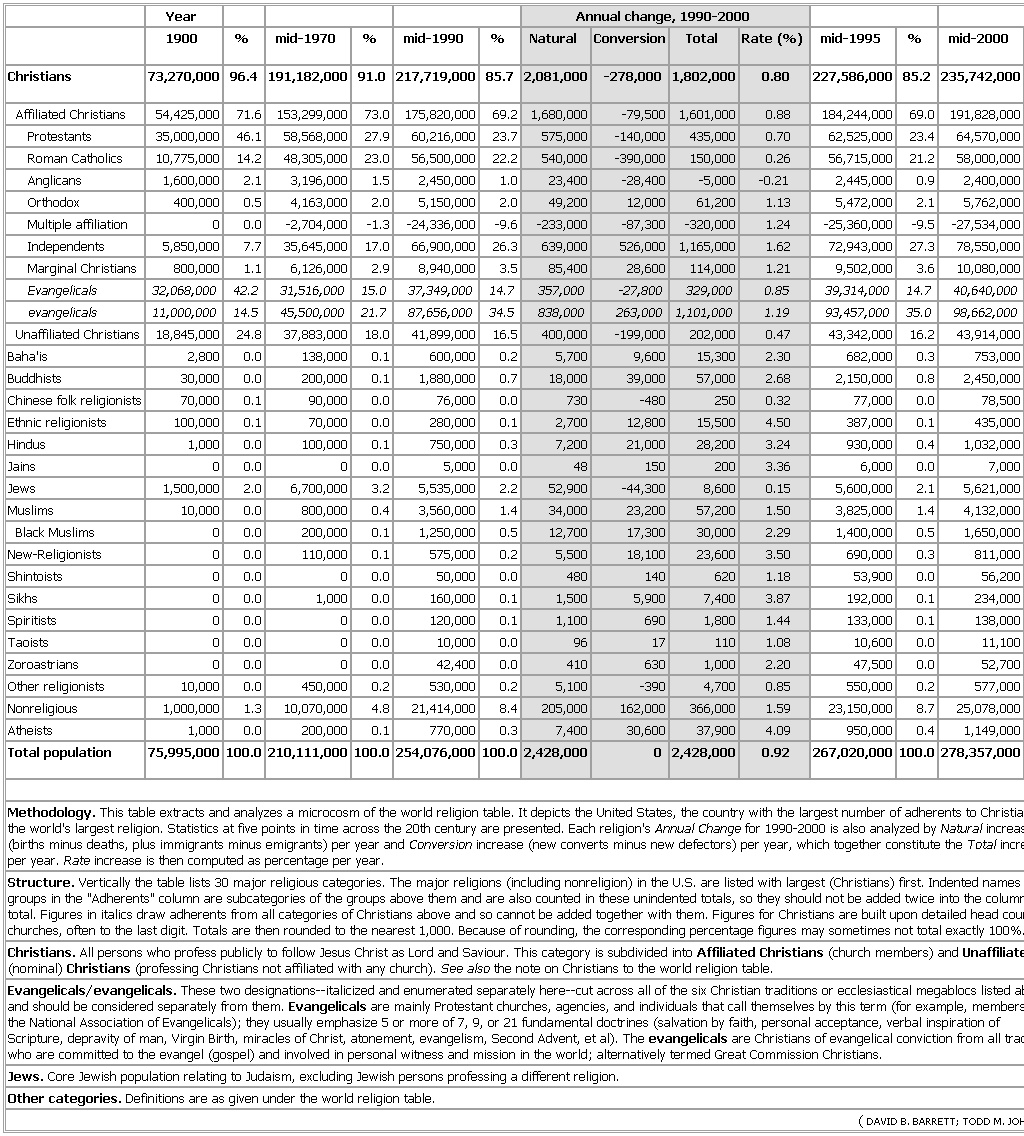- Religious Adherents in the United States of America, AD 1900-2000 1
-
▪ TableReligious Adherents in the United States of America, AD 1900-2000Year Annual change, 1990-2000Christians 73,270,000 96.4 191,182,000 91.0 217,719,000 85.7 2,081,000 -278,000 1,802,000 0.80 227,586,000 85.2 235,742,000 84.7Affiliated Christians 54,425,000 71.6 153,299,000 73.0 175,820,000 69.2 1,680,000 -79,500 1,601,000 0.88 184,244,000 69.0 191,828,000 68.9Protestants 35,000,000 46.1 58,568,000 27.9 60,216,000 23.7 575,000 -140,000 435,000 0.70 62,525,000 23.4 64,570,000 23.2Roman Catholics 10,775,000 14.2 48,305,000 23.0 56,500,000 22.2 540,000 -390,000 150,000 0.26 56,715,000 21.2 58,000,000 20.8Anglicans 1,600,000 2.1 3,196,000 1.5 2,450,000 1.0 23,400 -28,400 -5,000 -0.21 2,445,000 0.9 2,400,000 0.9Orthodox 400,000 0.5 4,163,000 2.0 5,150,000 2.0 49,200 12,000 61,200 1.13 5,472,000 2.1 5,762,000 2.1Multiple affiliation 0 0.0 -2,704,000 -1.3 -24,336,000 -9.6 -233,000 -87,300 -320,000 1.24 -25,360,000 -9.5 -27,534,000 -9.9Independents 5,850,000 7.7 35,645,000 17.0 66,900,000 26.3 639,000 526,000 1,165,000 1.62 72,943,000 27.3 78,550,000 28.2Marginal Christians 800,000 1.1 6,126,000 2.9 8,940,000 3.5 85,400 28,600 114,000 1.21 9,502,000 3.6 10,080,000 3.6Evangelicals 32,068,000 42.2 31,516,000 15.0 37,349,000 14.7 357,000 -27,800 329,000 0.85 39,314,000 14.7 40,640,000 14.6evangelicals 11,000,000 14.5 45,500,000 21.7 87,656,000 34.5 838,000 263,000 1,101,000 1.19 93,457,000 35.0 98,662,000 35.4Unaffiliated Christians 18,845,000 24.8 37,883,000 18.0 41,899,000 16.5 400,000 -199,000 202,000 0.47 43,342,000 16.2 43,914,000 15.8Baha'is 2,800 0.0 138,000 0.1 600,000 0.2 5,700 9,600 15,300 2.30 682,000 0.3 753,000 0.3Buddhists 30,000 0.0 200,000 0.1 1,880,000 0.7 18,000 39,000 57,000 2.68 2,150,000 0.8 2,450,000 0.9Chinese folk religionists 70,000 0.1 90,000 0.0 76,000 0.0 730 -480 250 0.32 77,000 0.0 78,500 0.0Ethnic religionists 100,000 0.1 70,000 0.0 280,000 0.1 2,700 12,800 15,500 4.50 387,000 0.1 435,000 0.2Hindus 1,000 0.0 100,000 0.1 750,000 0.3 7,200 21,000 28,200 3.24 930,000 0.4 1,032,000 0.4Jains 0 0.0 0 0.0 5,000 0.0 48 150 200 3.36 6,000 0.0 7,000 0.0Jews 1,500,000 2.0 6,700,000 3.2 5,535,000 2.2 52,900 -44,300 8,600 0.15 5,600,000 2.1 5,621,000 2.0Muslims 10,000 0.0 800,000 0.4 3,560,000 1.4 34,000 23,200 57,200 1.50 3,825,000 1.4 4,132,000 1.5Black Muslims 0 0.0 200,000 0.1 1,250,000 0.5 12,700 17,300 30,000 2.29 1,400,000 0.5 1,650,000 0.6New-Religionists 0 0.0 110,000 0.1 575,000 0.2 5,500 18,100 23,600 3.50 690,000 0.3 811,000 0.3Shintoists 0 0.0 0 0.0 50,000 0.0 480 140 620 1.18 53,900 0.0 56,200 0.0Sikhs 0 0.0 1,000 0.0 160,000 0.1 1,500 5,900 7,400 3.87 192,000 0.1 234,000 0.1Spiritists 0 0.0 0 0.0 120,000 0.1 1,100 690 1,800 1.44 133,000 0.1 138,000 0.1Taoists 0 0.0 0 0.0 10,000 0.0 96 17 110 1.08 10,600 0.0 11,100 0.0Zoroastrians 0 0.0 0 0.0 42,400 0.0 410 630 1,000 2.20 47,500 0.0 52,700 0.0Other religionists 10,000 0.0 450,000 0.2 530,000 0.2 5,100 -390 4,700 0.85 550,000 0.2 577,000 0.2Nonreligious 1,000,000 1.3 10,070,000 4.8 21,414,000 8.4 205,000 162,000 366,000 1.59 23,150,000 8.7 25,078,000 9.0Atheists 1,000 0.0 200,000 0.1 770,000 0.3 7,400 30,600 37,900 4.09 950,000 0.4 1,149,000 0.4Total population 75,995,000 100.0 210,111,000 100.0 254,076,000 100.0 2,428,000 0 2,428,000 0.92 267,020,000 100.0 278,357,000 100.0Methodology. This table extracts and analyzes a microcosm of the world religion table. It depicts the United States, the country with the largest number of adherents to Christianity, the world's largest religion. Statistics at five points in time across the 20th century are presented. Each religion's Annual Change for 1990-2000 is also analyzed by Natural increase (births minus deaths, plus immigrants minus emigrants) per year and Conversion increase (new converts minus new defectors) per year, which together constitute the Total increase per year. Rate increase is then computed as percentage per year.Structure. Vertically the table lists 30 major religious categories. The major religions (including nonreligion) in the U.S. are listed with largest (Christians) first. Indented names of groups in the "Adherents" column are subcategories of the groups above them and are also counted in these unindented totals, so they should not be added twice into the column total. Figures in italics draw adherents from all categories of Christians above and so cannot be added together with them. Figures for Christians are built upon detailed head counts by churches, often to the last digit. Totals are then rounded to the nearest 1,000. Because of rounding, the corresponding percentage figures may sometimes not total exactly 100%.Christians. All persons who profess publicly to follow Jesus Christ as Lord and Saviour. This category is subdivided into Affiliated Christians (church members) and Unaffiliated (nominal) Christians (professing Christians not affiliated with any church). See also the note on Christians to the world religion table.Evangelicals/evangelicals. These two designations—italicized and enumerated separately here—cut across all of the six Christian traditions or ecclesiastical megablocs listed above and should be considered separately from them. Evangelicals are mainly Protestant churches, agencies, and individuals that call themselves by this term (for example, members of the National Association of Evangelicals); they usually emphasize 5 or more of 7, 9, or 21 fundamental doctrines (salvation by faith, personal acceptance, verbal inspiration of Scripture, depravity of man, Virgin Birth, miracles of Christ, atonement, evangelism, Second Advent, et al). The evangelicals are Christians of evangelical conviction from all traditions who are committed to the evangel (gospel) and involved in personal witness and mission in the world; alternatively termed Great Commission Christians.Jews. Core Jewish population relating to Judaism, excluding Jewish persons professing a different religion.Other categories. Definitions are as given under the world religion table.(DAVID B. BARRETT; TODD M. JOHNSON)See as table:

* * *
Universalium. 2010.
